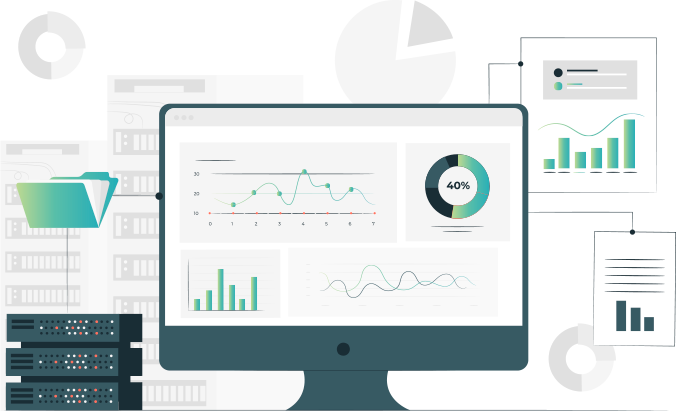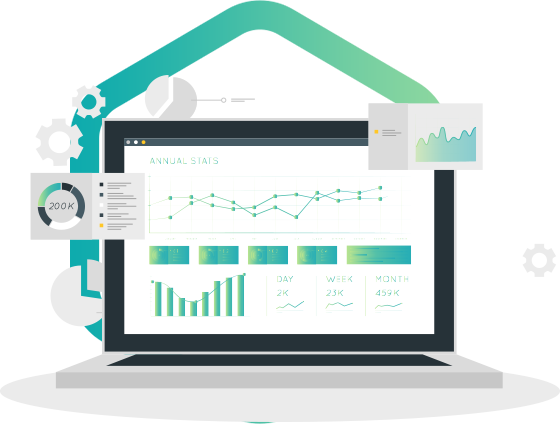Monitor, analyze, and optimize ServiceNow performance, allowing businesses to make data-driven decisions to improve the user experience with ServiceNow Performance Analytics.

ServiceNow Performance Analytics
ServiceNow Performance Analytics is a powerful tool that enables organizations to gain valuable insights into their Now platforms. It collects data from various sources within the ServiceNow instance and displays it in a range of dashboards and reports. Organizations can use this data to identify bottlenecks, track service level agreements (SLAs), and measure key performance indicators (KPIs) related to ServiceNow performance. It also enables users to drill down into specific metrics to identify the root cause of performance issues and take corrective action.
Benefits of Performance Analytics
Improved decision-making
Allows organizations to make data-driven decisions based on insights gained from analyzing performance data. By tracking key performance indicators, organizations can identify areas for improvement and take corrective action to optimize their processes.
Increased efficiency
Enables organizations to identify bottlenecks and inefficiencies in their processes. By addressing these issues, you can improve the efficiency of their operations and reduce time and resources.
Enhanced service quality
Helps track IT services’ effectiveness and makes data-driven decisions. By monitoring performance metrics, you can identify improvement areas and take corrective action to ensure the needs meet users.
Better resource allocation
Enables to allocate resources more effectively by identifying underutilized or overutilized areas. By optimizing resource allocation, you can improve the efficiency of their operations and reduce costs.
Increased Efficiency
Automates the process of mapping IT services and infrastructure components. It can reduce manual effort, improve accuracy, and increase efficiency.
Better collaboration and communication
Provides a common language and metrics for teams. By using the same performance data and metrics, teams can collaborate more effectively and clearly communicate their goals and progress.
ServiceNow performance analytics roles
Performance Analytics Administrator
Responsible for configuring & managing the app. They create & manage scorecards, dashboards, reports, and indicators, managing data sources & configuring data collection & aggregation.
Performance Analytics Viewer
Responsible for viewing and interacting with Performance Analytics content, such as scorecards, dashboards, and reports. They can also create and save their own personal dashboards and reports.
Performance Analytics Editor
This role has the same privileges as the Performance Analytics Viewer role but can also create and modify Performance Analytics content, such as scorecards, dashboards, and reports.
Data Collector
Responsible for collecting & aggregating data from ServiceNow tables and other data sources. They are typically ServiceNow administrators or developers responsible for configuring the data collection settings.
Data Source Administrator
Responsible for configuring and managing data sources for Performance Analytics. They can create and manage data source configurations, such as database connections, web service integrations, and file imports.
Data Owner
Responsible for the accuracy and completeness of the data used in Performance Analytics. Data Owners are typically subject matter experts responsible for the quality and integrity of the data in their respective areas.
ServiceNow performance analytics examples
Incident Management
Monitor the performance of the incident management process. Organizations can use this data to identify areas for improvement and optimize the incident management process to improve service quality and efficiency.
Change Management
Track the performance of the change management process. Organizations can use this data to identify bottlenecks and inefficiencies in the change management process and optimize the process to improve efficiency and reduce the risk of service outages.
Service Level Management
Monitor the performance of SLAs, including metrics such as compliance, average resolution time, and customer satisfaction scores. Organizations can use this data to identify areas for improvement and optimize service delivery to meet users’ needs.
IT Operations
Monitor the performance of IT operations, including metrics such as server uptime, network latency, and app response time. Organizations can use this data to identify service quality issues and take corrective action to ensure that IT services are delivered effectively.
Employee Experience
Track employee experience metrics, such as employee satisfaction scores, employee engagement levels, & HRSD metrics. Organizations can use this data to identify areas for improvement and optimize HR service delivery to meet the needs of employees.
Incident Resolution Time by Priority
Measures the time it takes to resolve incidents based on their priority level. Organizations can use this data to understand how long it takes to resolve incidents based on their severity level and prioritize resources accordingly.
ServiceNow performance analytics best practices
Define clear objectives
Before implementing Performance Analytics, you must define clear goals for what you want to achieve. It includes identifying which KPIs are most important to your organization & the data sources to track them.
Keep it simple
Performance Analytics can be a complex tool, but you must keep your dashboards and reports simple & focused. Avoid cluttering it with too many metrics, and only include the most relevant metrics to your objectives.
Regularly review and refine your KPIs
Your organization’s goals and priorities may change over time, so it is essential to regularly review and refine your KPIs to ensure they are still relevant and aligned with your objectives.
Ensure data accuracy
Performance Analytics relies on accurate and timely data, so it is essential to ensure that data is regularly validated and corrected as necessary.
Collaborate across teams
Performance Analytics can be a powerful tool for fostering collaboration across teams. Encourage cross-functional teams to use Performance Analytics to track metrics and identify areas for improvement.
Train your users
Ensure that your Performance Analytics users receive proper training on using the tool effectively. It includes training on creating reports, dashboards, and indicators and interpreting & analyzing performance data.
Continuously improve
Performance Analytics is a tool that requires continuous improvement. Regularly review and analyze your dashboards and reports to identify areas for improvement & take corrective action as necessary.
Use Visualization Techniques
Performance Analytics provides a range of visualization options to create compelling & informative dashboards & reports. It includes data analysis and making informed decisions based on the insights.
ServiceNow performance analytics use cases
-
Capacity Management
Track system performance, monitor resource utilization, and forecast capacity requirements using ServiceNow Performance Analytics. It can help optimize resource allocation, ensure systems perform optimally, and avoid service disruptions due to resource constraints.
-
IT Financial Management
Track IT costs, identify cost-saving opportunities, and measure IT initiatives' return on investment (ROI) using ServiceNow Performance Analytics. It can help optimize IT spending, align IT investments with business priorities, and demonstrate the value of IT to the business.
-
Asset Management
Organizations can use ServiceNow Performance Analytics to track the lifecycle of assets, monitor asset utilization, and optimize asset performance. It can help organizations identify areas for improvement, reduce asset-related costs, and effectively ensure asset usage.
-
Project Management
ServiceNow Performance Analytics can be used to track and analyze the progress of IT projects. It can help organizations identify areas where projects are behind schedule or over budget and take corrective action to keep projects on track.

How can Aelum Consulting Help with ServiceNow performance analytics?
Aelum Consulting is a ServiceNow partner with extensive experience implementing and customizing ServiceNow solutions, including Performance Analytics. Aelum Consulting can help organizations with the following:
Implementation and Configuration
We help implement and configure ServiceNow Performance Analytics, ensuring it is set up correctly and optimized and meets the security and compliance requirements of the organization..
Data Management
We can assist organizations with data management tasks such as validation, cleansing, and integration. It ensures that the data used in Performance Analytics is accurate, complete, and consistent.
Customization and Reporting
We help customize Performance Analytics dashboards and reports to meet their needs. It can include creating custom visualizations, adding new data sources, and configuring reports to meet reporting needs.
Performance Optimization
We help optimize ServiceNow instances for Performance Analytics. It includes tuning the platform to ensure it can handle large amounts of data and optimizing queries to improve report performance.
Training and Support
We provide training and support for ServiceNow Performance Analytics. It includes end-user training, system administration training, and ongoing support to meet the organization’s needs over time.
Strategy and Roadmap Development
We can work with organizations to develop a Performance Analytics strategy & roadmap aligned with business objectives. It includes identifying KPIs, data governance policies, & DQA processes.
ServiceNow performance analytics indicators
First Contact Resolution Rate
Measures the percentage of issues or incidents resolved on the first contact with the support team.
Change Success Rate
Measures the percentage of successful changes implemented without causing any incidents or disruptions.
Service Availability
Measures the uptime and availability of critical services and applications, indicating how often the services are available to users.
Mean Time to Resolve (MTTR)
Measures the average time it takes to resolve incidents or issues from their reported time.
Service Request Cycle Time
Measures the average time it takes to complete service requests from when they are submitted.
SLA Compliance
Measures the percentage of service level agreements met, indicating the service levels provided to users.
Problem Resolution Rate
Measures the percentage of problems resolved permanently, indicating the effectiveness of the process.
Self-Service Utilization Rate
Measures the percentage of users who utilize self-service options for incident and service request management.
Customer Satisfaction (CSAT) Score
Measures customer satisfaction levels with the services provided, indicating service delivery effectiveness.
Change Failure Rate
Measures the percentage of changes that failed or resulted or disruptions, indicating the effectiveness of the process.
Frequently Asked Questions
- Identify the metrics you want to track: Identify the key performance indicators (KPIs) most relevant to your business goals and objectives. These could include metrics related to incident management, change management, service level management, asset management, and other areas.
- Configure ServiceNow Performance Analytics: Once you have identified the KPIs you want to track, you can configure ServiceNow Performance Analytics to collect and analyze the data. It may involve creating new performance analytics indicators or modifying existing ones to meet your needs.
- Analyze the data: You can use ServiceNow Performance Analytics to analyze data and gain insights into your IT service delivery performance. It may involve creating dashboards, reports, and visualizations to understand trends, identify patterns and make informed decisions based on the data.
- Take corrective actions: Based on the insights gained from the analysis, you can take disciplinary actions to address any identified issues or areas for improvement. It could involve adjusting processes, reallocating resources, or implementing new tools or technologies to improve service delivery.
- Monitor and refine: As you make changes to your IT service delivery processes, continue to monitor the performance data and refine your approach as needed. It will help you continuously improve your service delivery and ensure you meet your business goals and objectives.
- Collaborate and communicate: It’s important to involve stakeholders from across the organization in the ServiceNow Performance Analytics process. It can help ensure that everyone has access to the insights they need to make informed decisions and drive business outcomes.
ServiceNow ITOM (IT Operations Management) Performance Analytics is a specialized module within ServiceNow Performance Analytics designed to help organizations optimize the performance of their IT infrastructure and operations.
ITOM Performance Analytics provides a range of pre-built metrics, dashboards, and reports that enable IT teams to monitor and analyze key performance indicators (KPIs) related to IT infrastructure management, such as network performance, application availability, and server utilization. It can also be customized to track organization-specific KPIs and provide insights into areas to improve performance.
Some of the key features of ServiceNow ITOM Performance Analytics include:
- Pre-built KPIs: ITOM Performance Analytics provides a range of pre-built KPIs related to IT infrastructure management, such as network latency, server uptime, and application response time. These KPIs can be used as-is or customized to meet the organization’s needs.
- Customizable dashboards: ITOM Performance Analytics includes customizable dashboards that allow IT teams to view KPIs in real-time and identify trends and patterns. Organizations can configure dashboards to display KPIs at a high level or provide detailed insights into specific areas of IT infrastructure management.
- Analytics workbench: ITOM Performance Analytics includes an analytics workbench allowing IT teams to create and customize their KPIs and reports. It enables organizations to track performance against organization-specific goals and objectives.
- Automated data collection: ITOM Performance Analytics automatically collects data from various sources, such as network devices, servers, and applications. This data is normalized and analyzed to provide insights into IT infrastructure performance.
- Integration with ServiceNow ITOM: ITOM Performance Analytics integrates with ServiceNow ITOM, which provides a suite of tools for IT infrastructure management, including network automation, event management, and discovery. This integration enables IT teams to view KPIs and performance data within the context of their IT infrastructure management processes.
ServiceNow Web Analytics is a module within the ServiceNow Performance Analytics platform that enables organizations to track and analyze user behaviour on their websites. This module provides insights into user engagement, content effectiveness, and website performance, which can help organizations optimize their online presence and improve the user experience.
Some of the key features of ServiceNow Web Analytics include:
- Tracking and analysis: ServiceNow Web Analytics tracks and analyzes user behaviour on websites, including page views, clicks, and session duration. It can also track user demographics, such as location and device type.
- Customizable dashboards: ServiceNow Web Analytics provides customizable dashboards that enable organizations to view website performance data in real-time. You can configure these dashboards to display KPIs related to website traffic, user engagement, and content effectiveness.
- A/B testing: ServiceNow Web Analytics includes A/B testing capabilities that enable organizations to compare the performance of different website variations. It can help organizations determine which website design or content most engages users.
- Integration with other ServiceNow modules: ServiceNow Web Analytics integrates with other ServiceNow modules, such as ServiceNow ITOM and ServiceNow Customer Service Management. This integration enables organizations to view website performance data within the context of their overall IT infrastructure and customer service operations.
- GDPR compliance: ServiceNow Web Analytics complies with the General Data Protection Regulation (GDPR), a regulation in the European Union that governs the collection and use of personal data. It ensures that organizations can collect and analyze website user data compliantly.
By using ServiceNow Web Analytics, organizations can gain insights into website performance and user behaviour, which can help them optimize their online presence and improve the user experience. With the ability to track and analyze user engagement, content effectiveness, and website performance, organizations can make data-driven decisions to drive business outcomes.
Benefits of using ServiceNow Performance Analytics include improved decision-making, better resource allocation, enhanced collaboration, and increased operational efficiency.
Best practices for using ServiceNow Performance Analytics include defining clear goals and objectives, establishing a governance model, ensuring data accuracy and completeness, using automation where possible, and promoting user adoption.
ServiceNow ITOM Performance Analytics is a specialized module within ServiceNow Performance Analytics designed to help organizations optimize the performance of their IT infrastructure and operations.
ServiceNow Web Analytics is a module within ServiceNow Performance Analytics that enables organizations to track and analyze user behaviour on their websites.
ServiceNow Performance Analytics focuses on tracking and analyzing KPIs related to business operations, while ServiceNow Operational Intelligence focuses on analyzing real-time operational data to identify patterns and trends and provide proactive insights.
Yes, you can customize the ServiceNow Performance Analytics to track organization-specific KPIs and provide insights into areas for improved performance.
ServiceNow Performance Analytics administrators are responsible for configuring and maintaining the module, ensuring data accuracy and completeness, and promoting user adoption. They may also be responsible for creating and maintaining custom KPIs and dashboards.
Our Clients


























































